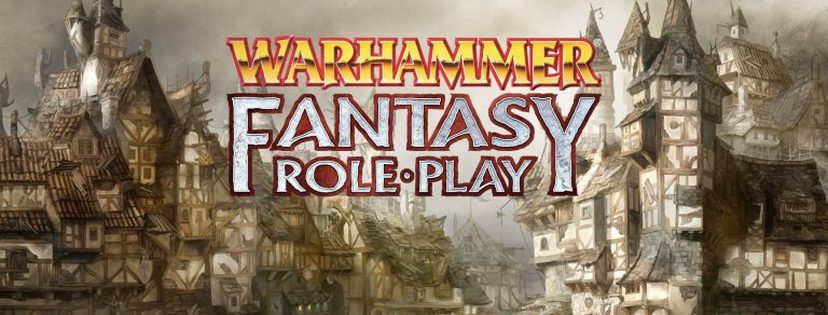 Let’s get one thing straight: I love Warhammer. I started with Warhammer 40,000 in my freshman year of high school, then was dragged into Warhammer Fantasy Battles before graduation. I left the hobby behind for years because I was broke (J/K! Still am!). As an adult I picked up roleplaying games. Needless to say, I was pretty stoked when I realized the newest edition of Warhammer Fantasy R oleplay was in development and the game went to the top of my “must play” list, along with many others who are craving Old World action (RIP WFB). Now that the game is here, does it live it to the expectations and standards of 30 years of WFRP history? Full disclosure: I was provided with a copy of the PDF for review purposes. 1) Combat Combat in WFRP is quick, narrative, and brutal. Cubicle 7 managed to tweak the typically slow pace of combat that is usually found in BRP games by adding in the advantage system. Attack rolls are always opposed and the winner is determined by who rolls the furthest under (or least over!) their melee skill. If the attacker wins, they hit and gain a cumulative +10% on their combat rolls; if the defender wins, they gain advantage. Whoever loses the roll also loses advantage. It’s also totally possible to crit will losing a roll, even if you’re defending, or fumble while succeeding; something that appeals to the black comedy inherent in the setting. It’s also pretty easy to knock characters down or kill them. In our second game, our party’s Apprentice Wizard lost half of his wounds to a single wolf bite. The following session, he was dropped to zero in two hits and nearly bled out. Thankfully PCs have resources at their disposal to keep themselves from dying on their first few adventures. Fate, fortune, resolve, and resilience allow PCs to avoid death, cancel out conditions like bleeding, prevent mutations (for now…) or possibly avoid the effects of critical hits. Crits don’t just do extra damage, they can maim or kill your character. You may not die, but have fun walking around without your left foot. 2) Careers Careers have been in WFRP since the game began in the 1980s, but they’ve been reimagined for the new edition. Career paths have been unified (it’s now easier to make it from an Interrogator to Witchfinder General) and lumped together in classes, which is mostly arrangement by theme. The list of careers is broad and varied. It’s possible to play anything from a Rat Catcher to a Noble, River Warden to Investigator. The careers can lead to some interesting parties. If you choose randomly, something encouraged by the game through bonus experience, you can wind up with a party that has a Scholar, a Witch, a Witch Hunter, and a Servant. That’s pretty diverse, but it can lead to narrative issues. Why is a servant out adventuring? And let’s hope the Witch Hunter doesn’t find out about the Witch! Careers can be changed through spending experience, allowing players to make the characters they really want to play, and allowing them to pick up skills and talents they can’t advance through their current skills. GMs are also encouraged to change PC careers based on narrative. On the lam? Now you’re all Outlaws. Did the Wizard start messing with dark magic? I guess he’s a Witch now. 3) Status Seeing as the setting is based on Renaissance Germany, it not terribly surprising to see class and status show up in the game. Status influences how much money you can earn between adventures (remember, they’re careers, not classes), and how you interact with others; it’s a bit tougher to for a beggar to intimidate a merchant than it would be for a noble. It feels like a gritty, grimdark world where the rich feast and the poor pick up the scraps. 4) So Many Things To Keep Track Of There’s a lot going on in this game and a lot to keep track of. Characters have to think about where their armour is covering them, how many fate, fortune, resilience and resolve points they have, lingering wounds from critical hits, whether or not there’s an infection from those wounds, and corruption from Chaotic influences. All of this on top of the encumbrance packed on their backs. It can be overwhelming. Fortunately there are a ton of optional rules to reduce the amount bookkeeping, simplifying armour points, and reminding the GM they can ignore encumbrance as they see fit. But out of the box the game gives you a lot of to keep track of, especially between adventures. 5) Progressive-ish I have to admit, I wasn’t expecting to find a game full of inclusivity, and I didn’t. Well, not entirely. There were a few pleasant surprises. For starters, there are no “races”. Instead they have been rebranded as species which is a welcome change and way more accurate. They also explicitly state that regardless of the name of the career, it’s open to everyone. Yes, we all know that anyone can be a “Townsman”, but it’s nice to see it in writing. It’s also nice to see at least a couple of careers with female-gendered titles. Seeing Nun instead of Monk, and Riverwoman was a pleasant surprise. It is about a fifty/fifty split between male and female career examples (at least until they get to the soldiers). There’s also a surprising amount of people of color displayed. That was one of the biggest surprises. Not to say there is equal representation (it’s still overwhelmingly white), but seeing a black man as a Noble was a treat. It should also be said that ethnic diversity in the setting is something that hasn’t been well communicated from Games Workshop or other IP holders to consumers (myself included). The Empire, especially in the east, has a wide array of skin-tones and isn’t the pasty Germanic nation that I previously thought it was. That’s not to say that representation is perfect. As I’ve said before, it’s overwhelmingly white and gender representation slips. There’s also the nagging lore bits that type-cast non-human species. Dwarfs hang on to grudges, High Elves are aloof, Halflings like to eat, and Wood Elves are wild and xenophobic. There are “good” and “bad” species. There’s a ton of intolerance too. Xenophobia, sex-negativity (thanks Slaanesh), and a deeply ingrained fear of the different are baked into the setting. But I suppose it wouldn’t be grimdark, and therefore Warhammer, if it wasn’t there. 6) Organization and Clarity The book can be a bit scattershot and unclear. There are places where one would expect to find particular rules, but they aren’t there, or you have to go searching for a trail of breadcrumbs to find the appropriate rules. As an example, the rules for Size begin in the combat section, but are more fully fleshed out in the Bestiary section. This isn’t too unreasonable, but the specific rules for how size affect damage (Damaging and Impact) are found in the weapons rules. One would also expect to find Injuries and Critical Wounds immediately after determining damage, but they’re preceded by movement, conditions, and Fate and Resilience. None of this is to say that the organization lacks logic, but it could use improvement. Where the editorial team did fail, however, was clarity. The book lacks clear examples of how rules work in actual play, and can be contradictory at times. It would’ve been really nice to have at least one example of how combat actually plays out or how to build enough advantage to cast a tough spell. There are also rules that could be a bit clearer. The worst example is on off-hand penalties for defending. At one point the rules seem to indicate that the penalty only applies on attacks, but weapons in the parry group ignore that penalty. Overall, there is nothing so egregious that a well written and thought out FAQ and Errata couldn’t fix, but it’s disappointing that the book requires on at all. Despite the fiddly bits and lack of clarity, this game is fantastic. Veteran gamers can grok it in a session, though newcomers might take a little more time. It’s worth it, because when they pick it up combat flies by and turns into the lethal character grinder that veteran WFRP players expect. If gritty and lethal isn’t your thing, this isn’t the game for you. But if you’re a fan of the Old World, or want to keep get a little dirtier than your favorite game, pick up the new edition of Warhammer Fantasy Roleplay here. Image attribution: Cubicle 7 Entertainment Ltd. © Games Workshop 2018 Leave a Reply. |
All blog materials created and developed by the staff here at High Level Games Archives
April 2023
Categories
All
|
Proudly powered by Weebly



 RSS Feed
RSS Feed